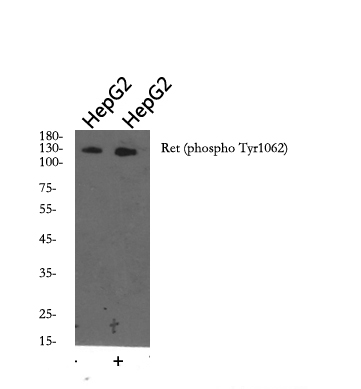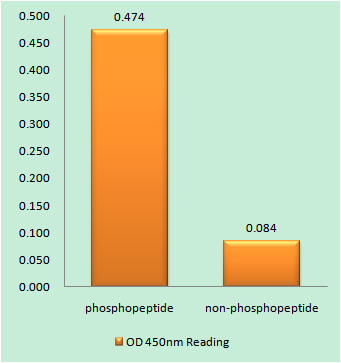
Catalog: KA1332C
Size
Price
Status
Qty.
96well
$470.00
In stock
0
Add to cart


Collected


Collect
Main Information
Reactivity
Human, Mouse, Rat
Applications
ELISA
Conjugate/Modification
Phospho
Detailed Information
Storage
2-8°C/6 months,Ship by ice bag
Modification
Phospho
Detection Method
Colorimetric
Related Products
Antigen&Target Information
Gene Name:
RET
show all
Other Name:
Proto-oncogene tyrosine-protein kinase receptor Ret ;
Cadherin family member 12 ;
Proto-oncogene c-Ret ;
[Cleaved into: Soluble RET kinase fragment ;
Extracellular cell-membrane anchored RET cadherin 120 kDa fragment]
Cadherin family member 12 ;
Proto-oncogene c-Ret ;
[Cleaved into: Soluble RET kinase fragment ;
Extracellular cell-membrane anchored RET cadherin 120 kDa fragment]
show all
Background:
catalytic activity:ATP + a [protein]-L-tyrosine = ADP + a [protein]-L-tyrosine phosphate.,disease:Chromosomal aberrations involving RET are a cause of thyroid papillary carcinoma (PACT) [MIM:188550]. Inversion inv(10)(q11.2;q21) generates the RET/CCDC6 (PTC1) oncogene; inversion inv(10)(q11.2;q11.2) generates the RET/NCOA4 (PTC3) oncogene; translocation t(10;14)(q11;q32) with GOLGA5 generates the RET/GOLGA5 (PTC5) oncogene; translocation t(8;10)(p21.3;q11.2) with PCM1 generates the PCM1/RET fusion; translocation t(6;10)(p21.3;q11.2) with RFP generates the Delta RFP/RET oncogene; translocation t(1;10)(p13;q11) with TRIM33 generates the TRIM33/RET (PTC7) oncogene; translocation t(7;10)(q32;q11) with TIF1 generates the TIF1/RET (PTC6) oncogene. The PTC5 oncogene has been found in 2 cases of PACT in children exposed to radioactive fallout after Chernobyl.,disease:Defects in RET are a cause of congenital central hypoventilation syndrome (CCHS) [MIM:209880]; also known as congenital failure of autonomic control or Ondine curse. CCHS is a rare disorder characterized by abnormal control of respiration in the absence of neuromuscular or lung disease, or an identifiable brain stem lesion. A deficiency in autonomic control of respiration results in inadequate or negligible ventilatory and arousal responses to hypercapnia and hypoxemia.,disease:Defects in RET are a cause of Hirschsprung disease (HSCR) [MIM:142623]. HSCR is a genetic disorder of neural crest development characterized by the absence of intramural ganglion cells in the hindgut, often resulting in intestinal obstruction. Occasionally, MEN2A or FMTC occur in association with HSCR.,disease:Defects in RET are a cause of pheochromocytoma [MIM:171300]. The pheochromocytomas are catecholamine-producing, chromaffin tumors that arise in the adrenal medulla in 90% of cases. In the remaining 10% of cases, they develop in extra-adrenal sympathetic ganglia and may be referred to as "paraganglioma." Pheochromocytoma usually presents with hypertension. Approximately 10% of pheochromocytoma is hereditary. The genetic basis for most cases of non-syndromic familial pheochromocytoma is unknown.,disease:Defects in RET are a cause of renal adysplasia [MIM:191830]; also known as renal agenesis or renal aplasia. Renal agenesis refers to the absence of one (unilateral) or both (bilateral) kidneys at birth. Bilateral renal agenesis belongs to a group of perinatally lethal renal diseases, including severe bilateral renal dysplasia, unilateral renal agenesis with contralateral dysplasia and severe obstructive uropathy.,disease:Defects in RET are the cause of medullary thyroid carcinoma (MTC) [MIM:155240]. MTC is a rare tumor derived from the C cells of the thyroid. Three hereditary forms are known, that are transmitted in an autosomal dominant fashion: (a) multiple neoplasia type 2A (MEN2A), (b) multiple neoplasia type IIB (MEN2B) and (c) familial MTC (FMTC), which occurs in 25-30% of MTC cases and where MTC is the only clinical manifestation.,disease:Defects in RET are the cause of multiple neoplasia type 2A (MEN2A) [MIM:171400]; also called multiple neoplasia type 2 (MEN2). MEN2A, the most frequent form of MTC, is an inherited cancer syndrome characterized by MTC, phaeochromocytoma and/or hyperparathyroidism.,disease:Defects in RET are the cause of multiple neoplasia type 2B (MEN2B) [MIM:162300]. MEN2B is an uncommon inherited cancer syndrome characterized by predisposition to MTC and phaeochromocytoma which is associated with marfanoid habitus, mucosal neuromas, skeletal and ophtalmic abnormalities, and ganglioneuromas of the intestine tract. Then the disease progresses rapidly with the development of metastatic MTC and a pheochromocytome in 50% of cases.,disease:Defects in RET may be a cause of colorectal cancer (CRC) [MIM:114500].,function:Probable receptor with tyrosine-protein kinase activity; important for development.,polymorphism:The Cys-982 polymorphism may be associated with an increased risk for developing Hirschsprung disease.,PTM:Autophosphorylated on C-terminal tyrosine residues upon ligand stimulation.,PTM:Phosphorylated.,similarity:Belongs to the protein kinase superfamily. Tyr protein kinase family.,similarity:Contains 1 cadherin domain.,similarity:Contains 1 protein kinase domain.,subunit:Phosphorylated form interacts with the PBT domain of DOK2, DOK4 and DOK5.,
show all
Function:
MAPKKK cascade, microtubule cytoskeleton organization, urogenital system development, metanephros development,ureteric bud development, ameboidal cell migration, neural crest cell migration, kidney development, embryonic epithelial tube formation, morphogenesis of an epithelium, protein amino acid phosphorylation, phosphorus metabolic process, phosphate metabolic process, cell motion, cytoskeleton organization, microtubule-based process, cell adhesion, homophilic cell adhesion, cell surface receptor linked signal transduction, enzyme linked receptor protein signaling pathway, transmembrane receptor protein tyrosine kinase signaling pathway, intracellular signaling cascade,protein kinase cascade, midgut development, posterior midgut development, mesenchymal cell development, neural crest cell development, neural crest cell differentiation, phosphorylation, morphogenesis of embryonic epithelium, cell-cell adhesion, cell migration, developmental maturation, biological adhesion, neuron differentiation, tube lumen formation, tube morphogenesis, tube development, neuron maturation, cell maturation, autonomic nervous system development, enteric nervous system development, gut development, embryonic morphogenesis, neuron development, tissue morphogenesis, mesenchymal cell differentiation, cell motility, localization of cell, epithelium development, mesenchyme development, epithelial tube morphogenesis,
show all
Cellular Localization:
Cell membrane ; Single-pass type I membrane protein . Endosome membrane ; Single-pass type I membrane protein . Predominantly located on the plasma membrane. In the presence of SORL1 and GFRA1, directed to endosomes. .
show all
Signaling Pathway
Human Diseases >> Cancer: overview >> Pathways in cancer
Human Diseases >> Cancer: overview >> Central carbon metabolism in cancer
Human Diseases >> Cancer: specific types >> Thyroid cancer
Human Diseases >> Cancer: specific types >> Non-small cell lung cancer
Environmental Information Processing >> Signal transduction >> MAPK signaling pathway
Environmental Information Processing >> Signal transduction >> Calcium signaling pathway
Environmental Information Processing >> Signal transduction >> PI3K-Akt signaling pathway
Reference Citation({{totalcount}})
Catalog: KA1332C
Size
Price
Status
Qty.
96well
$470.00
In stock
0
Add to cart


Collected


Collect
Recently Viewed Products
Clear allPRODUCTS
CUSTOMIZED
ABOUT US
Toggle night Mode
{{pinfoXq.title || ''}}
Catalog: {{pinfoXq.catalog || ''}}
Filter:
All
{{item.name}}
{{pinfo.title}}
-{{pinfo.catalog}}
Main Information
Target
{{pinfo.target}}
Reactivity
{{pinfo.react}}
Applications
{{pinfo.applicat}}
Conjugate/Modification
{{pinfo.coupling}}/{{pinfo.modific}}
MW (kDa)
{{pinfo.mwcalc}}
Host Species
{{pinfo.hostspec}}
Isotype
{{pinfo.isotype}}
Product {{index}}/{{pcount}}
Prev
Next
{{pvTitle}}
Scroll wheel zooms the picture
{{pvDescr}}


















